

Essay Writing. Academic Writing:Introduction. Just as there are differences in the way we use language for speech and for writing, there are also differences in the way we write for different situations; for example, compare the following written texts: Dear Mark, My accountant friend thinks that phone company shares are a good buy at the moment so I think I'll move some money into them...
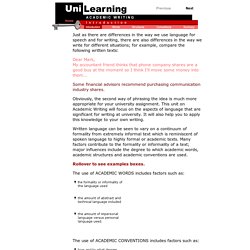
Some financial advisors recommend purchasing communication industry shares. Obviously, the second way of phrasing the idea is much more appropriate for your university assignment. This unit on Academic Writing will focus on the aspects of language that are significant for writing at university. It will also help you to apply this knowledge to your own writing. Written language can be seen to vary on a continuum of formality from extremely informal text which is reminiscent of spoken language to highly formal or academic texts. Rollover to see examples boxes. Gender differences in the consumption of meat, fruit and vegetables are similar in Finland and the Baltic countries.
Gender differences in the consumption of meat, fruit and vegetables are similar in Finland and the Baltic countries. Dietary Reference Intakes: Applications in Dietary Assessment. Digestive Processes - Basic Stages of Digestion, Simple Description. The Human Digestion Process (or, What Happens after You Eat Food) Digestion is the process of changing food into a form that the body can absorb and use as energy or as the raw materials to repair and build new tissue.
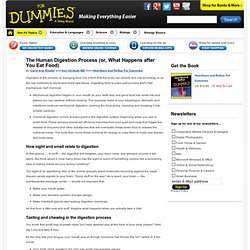
Digesting food is a two-part process that's half mechanical, half chemical. Digestive System. Digestive System For GC 1135 – General College – Murray Jensen Overview – Introduction The primary function of the digestive system is to take “food” and transform it into a form that can be absorbed by the blood.

There are two key terms here: transform and absorb. Brandisphysiologyspace.wikispaces. Insulin/Glucagon. The Important Role of Insulin and Glucagon in Maintaining Homeostasis The human body requires that the blood glucose level is maintained in a very narrow range.
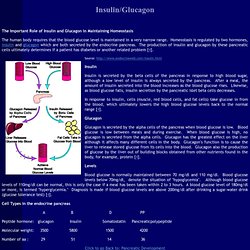
Homeostasis is regulated by two hormones, insulin and glucagon which are both secreted by the endocrine pancreas. The production of insulin and glucagon by these pancreatic cells ultimately determines if a patient has diabetes or another related problem [4]. Source: Insulin. The Effects of Exercise on the Body Systems. According to a report by the British Broadcasting Corporation report, the effects of exercise on your various body systems are felt both immediately and over time.
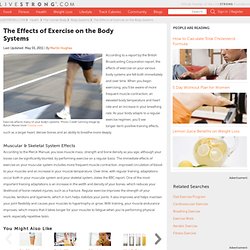
When you begin exercising, you'll be aware of more frequent muscle contraction, an elevated body temperature and heart rate and an increase in your breathing rate. As your body adapts to a regular exercise regimen, you'll see longer-term positive training effects, such as a larger heart, denser bones and an ability to breathe more deeply. Effects of Exercise on the Cardiovascular System. Effect on Heart Rate: Exercise uses up a lot of energy, which the cells derive from oxidizing glucose.
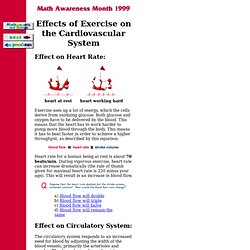
Both glucose and oxygen have to be delivered by the blood. This means that the heart has to work harder to pump more blood through the body. This means it has to beat faster in order to achieve a higher throughput, as described by this equation: Heart rate for a human being at rest is about 70 beats/min. A) Blood flow will double b) Blood flow will triple c) Blood flow will halve d) Blood flow will remain the same. The Effects of exercise on the Heart - HealthCentral.com.
Coronary Artery Disease.

People who maintain an active lifestyle have a 45% lower risk of developing heart disease than do sedentary people. Experts have been attempting to define how much exercise is needed to produce heart benefits. Beneficial changes in cholesterol and lipid levels, including lower LDL ("bad" cholesterol) levels, occur even when people performed low amounts of moderate- or high-intensity exercise, such as walking or jogging 12 miles a week. Benefits occur even with very modest weight loss, suggesting that overweight people who have trouble losing pounds can still achieve considerable heart benefits by exercising. Exercise and Cardiovascular Health. Jonathan Myers, PhD + Author Affiliations Correspondence to Jonathan Myers, PhD, Cardiology 111-C, VA Palo Alto Health Care System, 3801 Miranda Ave, Palo Alto, CA 94304.
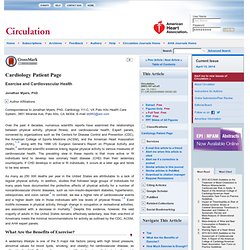
E-mail drj993@aol.com Over the past 4 decades, numerous scientific reports have examined the relationships between physical activity, physical fitness, and cardiovascular health. Expert panels, convened by organizations such as the Centers for Disease Control and Prevention (CDC), the American College of Sports Medicine (ACSM), and the American Heart Association (AHA),1–3 along with the 1996 US Surgeon General’s Report on Physical Activity and Health,4 reinforced scientific evidence linking regular physical activity to various measures of cardiovascular health. As many as 250 000 deaths per year in the United States are attributable to a lack of regular physical activity. Response of the Respiratory System to Exercise. Consisting of a series of body parts including the lungs, diaphragm and nasal cavity, the respiratory system is responsible for transporting oxygen and carbon dioxide to and from muscles and tissues.
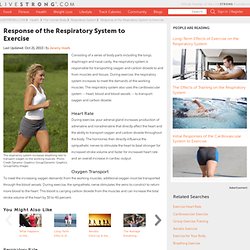
During exercise, the respiratory system increases to meet the demands of the working muscles. The respiratory system also uses the cardiovascular system -- heart, blood and blood vessels -- to transport oxygen and carbon dioxide. Exercise Physiology: Nutrition, Energy, and Human Performance - William D. McArdle, Frank I. Katch, Victor L. Katch. Since publication of its First Edition in 1981, Exercise Physiology has helped more than 350,000 students build a solid foundation of the scientific principles underlying modern exercise physiology.

This Seventh Edition has been thoroughly updated with all the most recent findings, guiding you to the latest understanding of nutrition, energy transfer, and exercise training and their relationship to human performance. This Seventh Edition maintains its popular seven-section structure.